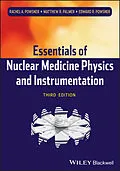An excellent introduction to the basic concepts of nuclear
medicine physics
This Third Edition of Essentials of Nuclear Medicine
Physics and Instrumentation expands the finely developed
illustrated review and introductory guide to nuclear medicine
physics and instrumentation. Along with simple, progressive, highly
illustrated topics, the authors present nuclear medicine-related
physics and engineering concepts clearly and concisely. Included in
the text are introductory chapters on relevant atomic structure,
methods of radionuclide production, and the interaction of
radiation with matter. Further, the text discusses the basic
function of the components of scintillation and non-scintillation
detector systems. An information technology section discusses PACs
and DICOM. There is extensive coverage of quality control
procedures, followed by updated chapters on radiation safety
practices, radiation biology, and management of radiation accident
victims.
Clear and concise, this new edition of Essentials of Nuclear
Medicine Physics and Instrumentation offers readers:
* Four new chapters
* Updated coverage of CT and hybrid scanning systems: PET/CT and
SPECT/CT
* Fresh discussions of the latest technology based on solid state
detectors and new scanner designs optimized for dedicated cardiac
imaging
* New coverage of PACs and DICOM systems
* Expanded coverage of image reconstruction and processing
techniques
* New material on methods of image display
Logically structured and clearly written, this is the book of
choice for anyone entering the field of nuclear medicine, including
nuclear medicine residents and fellows, cardiac nuclear medicine
fellows, and nuclear medicine technology students. It is also a
handy quick-reference guide for those already working in the field
of nuclear physics.
Autorentext
Rachel A. Powsner, MD, is Head of the Nuclear Medicine Section at the Veterans Administration Boston Healthcare System, and an Associate Professor of Radiology at Boston University. She is a practicing nuclear medicine physician, radiology faculty member at Boston University, and an author of the first two editions of this text.
Matthew R. Palmer, PhD, is the Nuclear Medicine Physicist at the Beth Israel Deaconess Medical Center and Assistant Professor of Radiology at Harvard Medical School in Boston, where he teaches in the nuclear medicine residency training program. Dr. Palmer is a welcome addition to the author team for the third edition of this book.
Edward R. Powsner, MD, is Former Chief of the Nuclear Medicine Service at the Veterans Administration Hospital in Ann Arbor, Michigan, where he is also Emeritus Professor and Associate Chairman, Department of Pathology, at Michigan State University. He is Former Chair of the Joint Review Committee for Educational Nuclear Medicine Technology and was a member of the American Board of Nuclear Medicine.
Zusammenfassung
An excellent introduction to the basic concepts of nuclear medicine physics
This Third Edition of Essentials of Nuclear Medicine Physics and Instrumentation expands the finely developed illustrated review and introductory guide to nuclear medicine physics and instrumentation. Along with simple, progressive, highly illustrated topics, the authors present nuclear medicine-related physics and engineering concepts clearly and concisely. Included in the text are introductory chapters on relevant atomic structure, methods of radionuclide production, and the interaction of radiation with matter. Further, the text discusses the basic function of the components of scintillation and non-scintillation detector systems. An information technology section discusses PACs and DICOM. There is extensive coverage of quality control procedures, followed by updated chapters on radiation safety practices, radiation biology, and management of radiation accident victims.
Clear and concise, this new edition of Essentials of Nuclear Medicine Physics and Instrumentation offers readers:
- Four new chapters
- Updated coverage of CT and hybrid scanning systems: PET/CT and SPECT/CT
- Fresh discussions of the latest technology based on solid state detectors and new scanner designs optimized for dedicated cardiac imaging
- New coverage of PACs and DICOM systems
- Expanded coverage of image reconstruction and processing techniques
- New material on methods of image display
Logically structured and clearly written, this is the book of choice for anyone entering the field of nuclear medicine, including nuclear medicine residents and fellows, cardiac nuclear medicine fellows, and nuclear medicine technology students. It is also a handy quick-reference guide for those already working in the field of nuclear physics.
Inhalt
Preface vii
Acknowledgements viii
1. Basic Nuclear Medicine Physics 1
2. Interaction of Radiation with Matter 21
3. Formation of Radionuclides 32
4. Non-scintillation Detectors 41
5. Scintillation Detectors 60
6. Imaging Instrumentation 73
7. Single Photon Emission Computed Tomography 91
8. Positron Emission Tomography 103
9. X-Ray Computed Tomography 119
10. Hybrid Imaging Systems: PET/CT and SPECT/CT 129
11. Image Reconstruction, Processing, and Display 134
12. Information Technology 161
13. Quality Control 168
14. Radiation Biology 185
15. Radiation Dosimetry 197
16. Radiation Safety 205
17. Management of Nuclear Event Casualties 212
Kevin Donohoe, MD
Appendix A: Common Radionuclides 224
Appendix B: Major Dosimetry for Common Radiopharmaceuticals
225
Appendix C: Sample Calculations for the S Value 226
Appendix D: Guide to Nuclear Regulatory Commission Publications
228
Appendix E: Recommended Reading by Topic 231
Index 232
